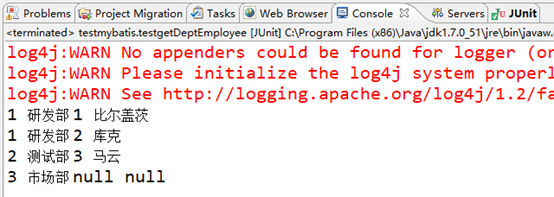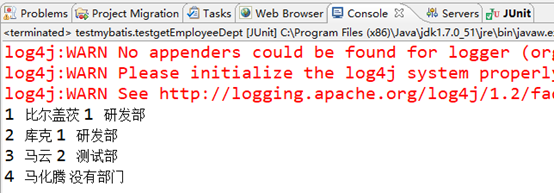MyBatis学习(二)---数据表之间关联
想要了解MyBatis基础的朋友可以通过传送门:
MyBatis学习(一)---配置文件,Mapper接口和动态SQL http://www.cnblogs.com/ghq120/p/8322302.html
本文主要介绍了用MyBatis实现数据表之间的各种关系,例如一对多,多对一,一对一和多对多。
一对多和多对一
本项目的例子为公司的部门和员工之间的关系,即一个部门对应多个员工,反过来多个员工对应一个部门即为多对一。
项目的目录为

本项目依旧使用Oracle数据库,对应的表为employee和department
employee表的列

department表

表对应的实体类分别为
Employee.java
package com.ghq.model.entity;
public class Employee {
private Integer id;
private String empName;
private Department dept;
public Employee(Integer id, String empName, Department dept) {
super();
this.id = id;
this.empName = empName;
this.dept = dept;
}
public Employee(String empName, Department dept) {
super();
this.empName = empName;
this.dept = dept;
}
public Employee() {
}
//此处省略setter/getter方法
@Override
public String toString() {
return "Employee [id=" + id + ", empName=" + empName + ", dept=" + dept
+ "]";
}
}
Department.java
package com.ghq.model.entity;
import java.util.List;
public class Department {
private Integer id;
private String deptname;
//部门下所有员工
private List<Employee> emps;
public Department(Integer id, String deptname, List<Employee> emps) {
super();
this.id = id;
this.deptname = deptname;
this.emps = emps;
}
public Department(String deptname, List<Employee> emps) {
super();
this.deptname = deptname;
this.emps = emps;
}
public Department() {
}
//此处省略setter/getter方法
@Override
public String toString() {
return "Department [id=" + id + ", deptname=" + deptname + ", emps="
+ emps + "]";
}
}
配置文件仍为mybatis-config.xml,其中定义了别名,指定了连接池和注册映射文件。
<?xml version="1.0" encoding="UTF-8" ?>
<!DOCTYPE configuration
PUBLIC "-//mybatis.org//DTD Config 3.0//EN"
"http://mybatis.org/dtd/mybatis-3-config.dtd">
<configuration>
<!-- 加载db.properties文件 -->
<properties resource="db.properties"></properties> <!-- 在配置文件中定义别名,可以在映射文件中使用别名 -->
<typeAliases>
<!-- 为该包下的实体类定义别名 -->
<package name="com.ghq.model.entity"/>
</typeAliases> <!-- 指定了默认的环境为development -->
<environments default="development">
<!-- 指出了环境的唯一标识 -->
<environment id="development">
<!-- 指出了事务管理器 -->
<transactionManager type="JDBC"/>
<!-- 指出了连接池,并指出了连接数据库的驱动,url,用户名,密码 -->
<dataSource type="POOLED">
<property name="driver" value="${db.driver}"/>
<property name="url" value="${db.url}"/>
<property name="username" value="${db.username}"/>
<property name="password" value="${db.password}"/>
</dataSource>
</environment>
</environments>
<!-- 注册映射文件 -->
<mappers>
<package name="com.ghq.model.dao"/>
</mappers>
</configuration>
db.properties文件中
db.driver=oracle.jdbc.driver.OracleDriver
db.url=jdbc:oracle:thin:@127.0.0.1:1521:orcl
db.username=scott
db.password=itcast
工具类下MybatisDb.java获取获取SqlSessionFactory以及SqlSession的对象,SqlSession中具有对数据表增删改查的方法
package com.ghq.model.utils; import java.io.IOException;
import java.io.InputStream; import org.apache.ibatis.io.Resources;
import org.apache.ibatis.session.SqlSession;
import org.apache.ibatis.session.SqlSessionFactory;
import org.apache.ibatis.session.SqlSessionFactoryBuilder; public class MybatisDb {
private static String config = "mybatis-config.xml";
private static SqlSessionFactory sqlSessionFac; static{
try {
//读取配置文件
InputStream inputstream = Resources.getResourceAsStream(config);
//获取SqlSessionFactory对象
sqlSessionFac = new SqlSessionFactoryBuilder().build(inputstream);
} catch (IOException e) {
e.printStackTrace();
}
} //获取SqlSession对象,并且开启了事务
public static SqlSession getSession(){
return sqlSessionFac.openSession();
} }
dao组件中
DeptDao主要是获取指定部门下的员工信息
public interface DeptDao {
//获取部门下员工信息(部门信息和员工信息)
public List<Department> getDeptEmployee();
}
EmpDao是获取每个员工的部门信息
public interface EmpDao {
//获取每个员工的部门信息
public List<Employee> getEmployeeDept();
}
Department中获取所有的员工的属性时集合类型的,在配置文件中使用的元素是<collection>,该元素必须添加property和ofType属性, property指出集合属性名,ofType指出集合元素的类型
Employee中员工对应的部门信息是实体类类型,在配置文件中使用<association>元素,该元素必须指定property和javaType,property指出的是实体的属性名,javaType指出了该属性的类型
DeptDao的配置文件为DeptDao.xml
<?xml version="1.0" encoding="UTF-8" ?>
<!DOCTYPE mapper
PUBLIC "-//mybatis.org//DTD Mapper 3.0//EN"
"http://mybatis.org/dtd/mybatis-3-mapper.dtd"> <mapper namespace="com.ghq.model.dao.DeptDao">
<resultMap type="Department" id="deptMap">
<id column="did" property="id"/>
<result column="deptname" property="deptname"/> <!-- 映射集合使用的元素是Collection,该元素必须添加property和ofType属性,
property指出集合属性名,ofType指出集合元素的类型 -->
<collection property="emps" ofType="Employee">
<id column="eid" property="id"/>
<result column="empname" property="empName"/>
</collection>
</resultMap> <select id="getDeptEmployee" resultMap="deptMap">
SELECT d.id did, d.deptname, e.id eid, e.empname
FROM department d LEFT JOIN employee e
ON d.id = e.deptid
</select> </mapper>
EmpDao的配置文件为EmpDao.xml
<?xml version="1.0" encoding="UTF-8" ?>
<!DOCTYPE mapper
PUBLIC "-//mybatis.org//DTD Mapper 3.0//EN"
"http://mybatis.org/dtd/mybatis-3-mapper.dtd"> <mapper namespace="com.ghq.model.dao.EmpDao"> <!-- 用于完成查询出的列名和相应实体属性的映射 -->
<resultMap type="Employee" id="empMap">
<!-- 用于映射主键列 -->
<id column="eid" property="id"/>
<!-- 用于映射普通列 -->
<result column="empname" property="empName"/> <!-- association元素必须指定property和javaType,property指出的是实体的属性名,javaType指出了该属性的类型 -->
<association property="dept" javaType="Department">
<id column="did" property="id"/>
<result column="deptname" property="deptname"/>
</association>
</resultMap> <!-- 查询出的列名和实体的属性名不一致,所以应该使用resultMap -->
<select id="getEmployeeDept" resultMap="empMap">
SELECT e.id eid, e.empname, d.id did, d.deptname
FROM employee e LEFT JOIN department d
ON d.id = e.deptid
</select> </mapper>
使用单元测试
public class testmybatis {
//此方法对应DeptDao,为测试获取部门下所有员工的方法
@Test
public void testgetDeptEmployee(){
SqlSession session = MybatisDb.getSession();
DeptDao deptDao = session.getMapper(DeptDao.class);
List<Department> depts = deptDao.getDeptEmployee();
session.close();
if (depts != null && depts.size() > 0) {
for (Department d : depts) {
List<Employee> emps = d.getEmps();
if (emps !=null && emps.size() > 0) {
for (Employee e : emps) {
System.out.println(d.getId()+" "+d.getDeptname()+" "+e.getId()+" "+e.getEmpName());
}
} else{
System.out.println(d.getId()+" "+d.getDeptname()+" "+null+" "+null);
}
}
}else {
System.out.println("沒有部门");
}
}
}

//此方法对应EmpDao,为测试员工对应部门的方法
@Test
public void testgetEmployeeDept(){
SqlSession session = MybatisDb.getSession();
EmpDao empDao = session.getMapper(EmpDao.class);
List<Employee> emps = empDao.getEmployeeDept();
session.close();
if (emps != null && emps.size() > 0) {
for (Employee e : emps) {
if (e.getDept() == null) {
System.out.println(e.getId()+" "+e.getEmpName()+" "+"没有部门");
}else{
System.out.println(e.getId()+" "+e.getEmpName()+" "+e.getDept().getId()+" "+e.getDept().getDeptname());
}
} } }

一对一
本项目为公民和身份证之间的关系,即一个公民对应一张身份证

对应的表分别为citi_tb和card_tb
citi_tb表

card_tb表

表对应的实体类分别为
Citi.java
package com.ghq.model.entity;
public class Citi {
private Integer id;
private String citiName;
private IdCard card;
public Citi(Integer id, String citiName, IdCard card) {
super();
this.id = id;
this.citiName = citiName;
this.card = card;
}
public Citi(String citiName, IdCard card) {
super();
this.citiName = citiName;
this.card = card;
}
public Citi() {
}
//此处省略setter/getter方法
}
IdCard.java
package com.ghq.model.entity;
public class IdCard {
private Integer id;
private String cardNo;
private String address;
private Citi citi;
public IdCard(Integer id, String cardNo, String address, Citi citi) {
super();
this.id = id;
this.cardNo = cardNo;
this.address = address;
this.citi = citi;
}
public IdCard(String cardNo, String address, Citi citi) {
super();
this.cardNo = cardNo;
this.address = address;
this.citi = citi;
}
public IdCard() {
super();
// TODO Auto-generated constructor stub
}
//此处省略setter/getter方法
}
工具类和配置文件都没有发生改变
dao组件中CitiDao
public interface CitiDao {
//获取每个公民的身份证信息
public List<Citi> getCitiIdCard();
}
CitiDao的配置文件CitiDao.xml
<?xml version="1.0" encoding="UTF-8" ?>
<!DOCTYPE mapper
PUBLIC "-//mybatis.org//DTD Mapper 3.0//EN"
"http://mybatis.org/dtd/mybatis-3-mapper.dtd"> <mapper namespace="com.ghq.model.dao.CitiDao"> <resultMap type="Citi" id="citiMap">
<id column="citiid" property="id"/>
<result column="citi_name" property="citiName"/> <association property="card" javaType="IdCard">
<id column="cardid" property="id"/>
<result column="card_no" property="cardNo"/>
<result column="address" property="address"/>
</association>
</resultMap> <select id="getCitiIdCard" resultMap="citiMap">
SELECT citi.id citiid, citi.citi_name, card.id cardid, card.card_no, card.address
FROM citi_tb citi LEFT JOIN card_tb card
ON citi.id = card.id
</select> </mapper>
单元测试的方法
public class testmybatis {
@Test
public void testgetCitiIdCard(){
SqlSession session = MybatisDb.getSession();
CitiDao citiDao = session.getMapper(CitiDao.class);
List<Citi> citis = citiDao.getCitiIdCard();
session.close();
if (citis != null && citis.size() > 0) {
for (Citi c : citis) {
System.out.println(c.getId()+" "+c.getCitiName()+" "+c.getCard().getId()+" "+c.getCard().getCardNo()+" "+c.getCard().getAddress());
}
}
}
}

多对多
本项目为学生信息表,选课表,选课成绩表之间的关系,即每一个学生可以选多门课,一门课对应多个学生。
项目的目录结构

Oracle中对应的表为
学生表stu_tbl2

课程表cour_tbl2

学生选课表stu_cour_tbl2

表所对应的实体类为
Stu.java
//学生实体类
public class Stu {
//标识属性
private Integer id;
//学生名
private String stuName;
//选修的课程
private List<StuCource> stuCources; //省略有参构造和无参构造函数,setter/getter方法
}
Course.java
//课程实体类
public class Cource {
//标识属性
private Integer id;
//课程名字
private String courceName;
//对应的选课记录
private List<StuCource> stuCources;
//省略有参构造和无参构造函数,setter/getter方法
}
StuCource.java
//选课实体
public class StuCource {
//标识属性
private Integer id;
//对应的学生
private Stu stu;
//对应的课程
private Cource cource;
//对应的成绩
private double score;
//省略有参构造和无参构造函数,setter/getter方法
}
dao组件中
public interface StuDao {
//获取每个学生选修课程信息以及成绩 包含了学生信息 课程信息 成绩信息
public List<Stu> getStuCource();
}
StuDao的配置文件StuDao.xml
<?xml version="1.0" encoding="UTF-8" ?>
<!DOCTYPE mapper
PUBLIC "-//mybatis.org//DTD Mapper 3.0//EN"
"http://mybatis.org/dtd/mybatis-3-mapper.dtd"> <mapper namespace="com.ghq.model.dao.StuDao"> <resultMap type="Stu" id="stuMap">
<id column="sid" property="id"/>
<result column="stu_name" property="stuName"/>
<collection property="stuCources" ofType="StuCource">
<id column="scid" property="id"/>
<result column="score" property="score"/>
<association property="cource" javaType="Cource">
<id column="cid" property="id"/>
<result column="cour_name" property="courceName"/>
</association>
</collection> </resultMap> <select id="getStuCource" resultMap="stuMap">
SELECT s.id SID,s.stu_name,c.id cid,c.cour_name,sc.id scid,sc.score
FROM stu_cour_tbl2 sc,stu_tbl2 s, cour_tbl2 c
WHERE sc.stu_id(+) = s.id AND sc.cour_id = c.id(+)
</select> </mapper>
单元测试中的方法
public class testmybatis {
@Test
public void testgetStuCource(){
SqlSession session = MybatisDb.getSession();
StuDao studao = session.getMapper(StuDao.class);
List<Stu> stus = studao.getStuCource();
session.close();
if (stus != null && stus.size() > 0) {
for (Stu stu : stus) {
List<StuCource> stuCources = stu.getStuCources();
if (stuCources !=null && stuCources.size() > 0) {
for (StuCource stuCource : stuCources) {
System.out.println(stu.getId()+" "+stu.getStuName()+" "+stuCource.getId()+" "+stuCource.getScore()
+" "+stuCource.getCource().getId()+" "+stuCource.getCource().getCourceName());
}
}else {
System.out.println(stu.getId()+" "+stu.getStuName()+" 该学生没有选课");
}
}
}else {
System.out.println("没有学生");
}
}
}

最新文章
- Hadoop Shell命令大全
- C10K 问题引发的技术变革
- 自制工具:迅速打开一个Node 环境的Playground
- 【转】android应用程序的安装方式与原理
- loadrunner数据库MySQL参数化列表乱码问题
- mongodb 2.6 window 安装启动服务
- c#类库中使用Session
- I.MX6 bq27441 driver hacking
- 2.5.6 使用progressDialog创建进度对话框
- Mosquitto-MQTT
- wpf使用devexpress RibbonControl实现导航窗体
- 深入浅出新一代云网络——VPC中的那些功能与基于OpenStack Neutron的实现(一)
- java封装的概念
- Jsp的基本知识
- 算法与数据结构(四) 图的物理存储结构与深搜、广搜(Swift版)
- 一个 Vue & Node 的全栈小项目
- hdu-1251(字典树)
- netty 在线教程
- id生成工具类
- Mac mysql sql_model引起的问题